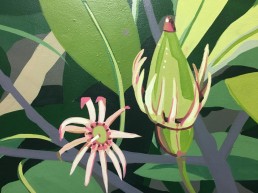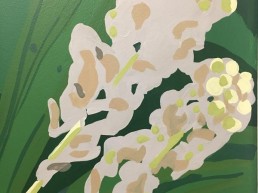A tropical forest was unveiled on 24th of October in Trinity College Dublin thanks to London-based mural artist, Josephine Hicks, whose latest masterpiece spans three walls of Trinity’s historic 1907 Botany Building.
The mural links the historic plant-hunting that took place at the turn of the 20th century to the tropical biodiversity and conservation research carried out by researchers and students today in Trinity Botanic Garden and Botany Department.

The species in the mural occur today in inland or coastal tropical forests of Thailand. Some are threatened by extinction. Others are common. Most have been directly observed, studied and collected by Trinity botanists past and present. All have a scientific story. One of the featured species, Mitrephora winitii, was used as inspiration for the colour palette for Trinity Botanic Garden’s website!
Director of Trinity Botanic Garden, Jennifer McElwain, said:
“Trinity’s botanists have an important role to play in conducting high-impact research that can make a huge societal impact for current and future generations. We hope the mural, which celebrates the process of science and the beauty of diversity, will act as an inspiration and reminder of that duty, underline the Botany Department’s historic and ongoing links with Thailand, and empower our students to make a difference for future climate and biodiversity.”
Artist, Josephine Hicks, added:
“I wanted to create an immersive painting where you are surrounded by oversized leaves, fruits and flowers, which transports you to the rich, dark and dense tropical forest. It’s been a fascinating and highly inspirational project, and I have been introduced to extraordinary species in celebrating the diversity of the area.”
Trinity-Thailand botany links
The Botany Department’s links with Thailand date back to 1902 when a medical graduate of Trinity from Co. Leitrim, A.F.G. Kerr, travelled to northern Thailand to take up the post of Medical Officer in Chiang Mai. He got the job via H.H. Dixon FRS, then Professor of Botany, whom he had become acquainted with during his degree.
Kerr travelled extensively by foot, boat and elephant in Thailand – all the time amassing huge collections of plant material, photographs, and other artefacts. Eventually, his botanical expertise was recognised: Kerr became Government Botanist, the first Director of the Botanical section of the Ministry of Commerce and then Director General of the Department of Agricultural Research. He returned to Europe in 1932 and donated his collections to a number of institutes, including Trinity. Kerr’s contribution is still recognised in Thailand where he is known as the Father of Thai Botany.
In 1985 the Botany Department’s connections with Thailand were renewed when Pranom Chantaraothai came to work with Trinity’s Professor John Parnell on Thai plant systematics (Syzygium). Since then Trinity’s links with Thailand have been continually strengthened, partly through a programme of extensive field-work.
The Botany Department welcomes members of the public to visit the mural and take a self-guided tour using the key below to the species featured.










